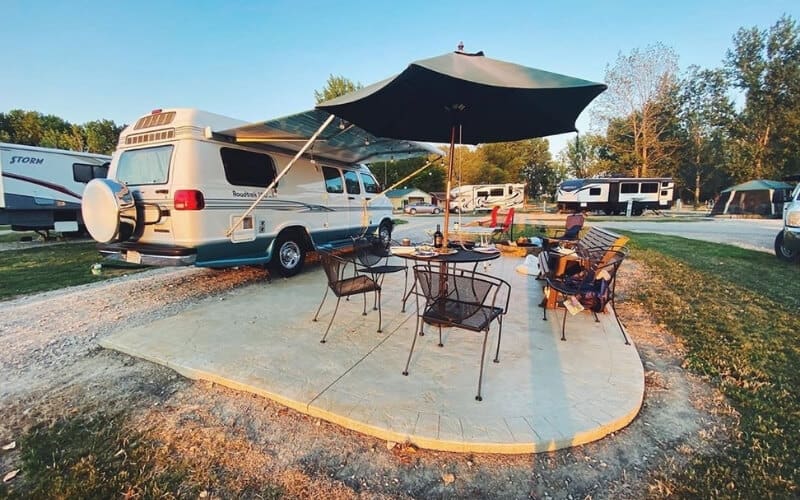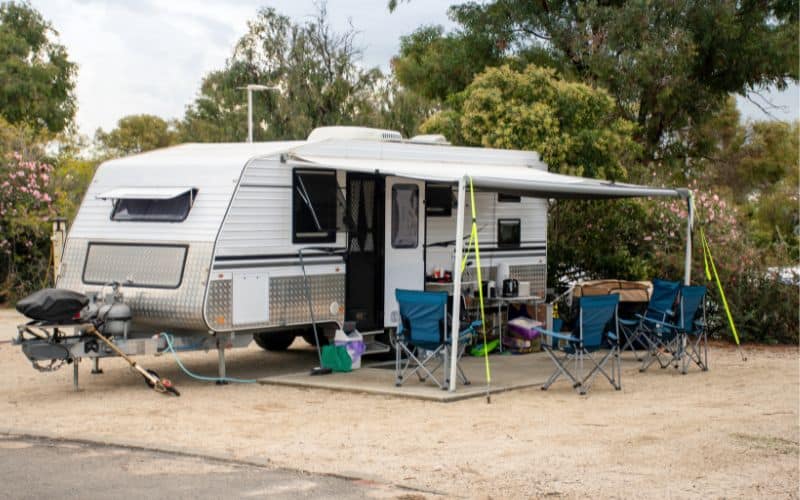There are many perks to traveling in an RV, since it offers all of the comforts of home in a convenient mobile setup that you can take almost anywhere.
Once you arrive at your next campsite, all you need to do is park, make sure the camper is level, and hook up to your campsite’s power and water.
Although your motorhome is equipped with a bathroom, kitchen, and sleeping areas, how much can you use your RV’s amenities while it’s on the move?
In general, is it legal to be inside an RV camper while it’s moving?
It’s illegal to sleep, walk around or even be inside an RV like a travel trailer, fifth wheel or any kind of pull-behind campers while it’s moving. However, you can sit inside a Class A, B, and C motorhome that has seat belts, and you can legally use some of the facilities inside while driving.
This article will cover what you can and cannot do inside your RV while it’s moving down the road.
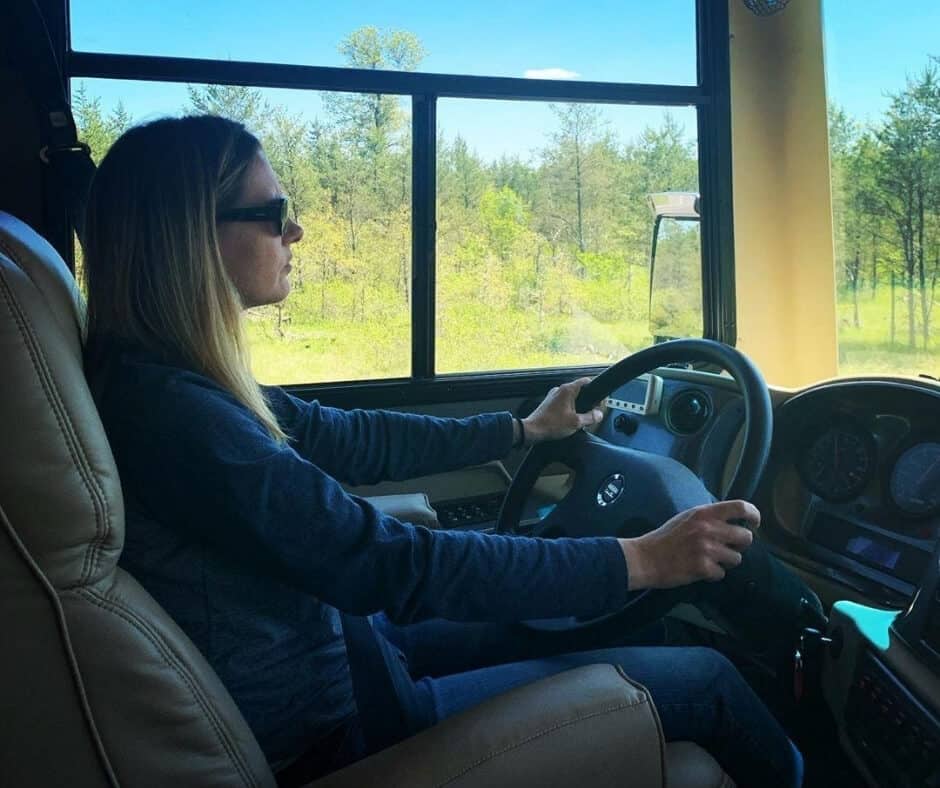
Why Can’t I Be Inside My Pull-Behind Camper While Driving?
If you’re traveling with a trailer or towed camper, you cannot be inside it while moving down the road.
So, if you need to use the bathroom or cook a meal, you’ll need to pull over or take a break at a rest stop in order to use your camper’s amenities.
Some of the reasons why you can’t sleep, cook, or walk around inside your trailer include:
- The camper isn’t designed to protect passengers while traveling
- It’s illegal to be inside the trailer while moving, so you must travel in the towing vehicle
- Towing and maneuverability may be negatively impacted if there are people inside the trailer while towing it
Pull-Behind Campers Are Not Safe for Passengers
All vehicles are designed for specific uses. While your car, truck, or SUV is meant to transport passengers safely, with seat belts, airbags and other protective design features such as crumple zones, motorhomes and campers are not built this way.
Trailers are especially unsafe for passengers, since they are not designed with safety features (there are no seat belts).
What’s more, a trailer’s frame is usually constructed from 2” by 2” wood and aluminum, which are not at all protective.
RVs and motorhomes have a little bit more safety, and they are designed to carry a driver and passengers, with seat belts and other features.
However, there are still some areas and activities that are unsafe (or illegal) while moving down the road.
Passengers in an RV should always sit in areas that are designed for travel, with seat belts buckled while the vehicle is in motion. Usually, these areas will be the sofa or dinette area.
It’s Illegal to Ride in a Vehicle Without a Seat Belt in Most States
Since pull-behind campers aren’t designed for passengers and don’t have seat belts, it’s illegal to ride in one while traveling.
However, you can ride in an RV or motorhome, as long as you’re buckled in. Most states require the driver and all passengers to wear a seat belt at all times while the vehicle is moving.
According to the CDC, wearing a seatbelt is a primary law in 32 states, and a secondary law in 18 states.
The only state where there’s no law about wearing a seatbelt is New Hampshire. Check out the chart below:
| State | Primary Law | Secondary Law | No Law |
|---|---|---|---|
| Alabama | X | ||
| Alaska | X | ||
| Arizona | X | ||
| Arkansas | X | ||
| California | X | ||
| Colorado | X | ||
| Connecticut | X | ||
| Delaware | X | ||
| District of Columbia | X | ||
| Florida | X | ||
| Georgia | X | ||
| Hawaii | X | ||
| Idaho | X | ||
| Illinois | X | ||
| Indiana | X | ||
| Iowa | X | ||
| Kansas | X | ||
| Kentucky | X | ||
| Louisiana | X | ||
| Maine | X | ||
| Maryland | X | ||
| Massachusetts | X | ||
| Michigan | X | ||
| Minnesota | X | ||
| Mississippi | X | ||
| Missouri | X | ||
| Montana | X | ||
| Nebraska | X | ||
| Nevada | X | ||
| New Hampshire | X | ||
| New Jersey | X | ||
| New Mexico | X | ||
| New York | X | ||
| North Carolina | X | ||
| North Dakota | X | ||
| Ohio | X | ||
| Oklahoma | X | ||
| Oregon | X | ||
| Pennsylvania | X | ||
| Rhode Island | X | ||
| South Carolina | X | ||
| South Dakota | X | ||
| Tennessee | X | ||
| Texas | X | ||
| Utah | X | ||
| Vermont | X | ||
| Virginia | X | ||
| Washington | X | ||
| West Virginia | X | ||
| Wisconsin | X | ||
| Wyoming | X |
Passengers Impact the Towing Function
RVs and motorhomes are self-sufficient vehicles, with the driving cab integrated into the design of the camper.
But trailers and fifth wheels require a truck or SUV to tow them, and you have to keep the camper’s Gross Vehicle Weight Rating (GVWR) and your towing vehicle’s towing weight capacity in mind to ensure safe travel.
Check out our recent article about the average weight of a travel trailer to learn more.
Beyond your gear, supplies and the camper itself, there are lots of things that add weight to the camper, and all of these things affect your ability to tow it safely.
A heavier camper will be harder to tow and more difficult to maneuver.
Additionally, campers are built to distribute weight evenly, so if there are people inside, the weight distribution will be thrown off and the camper may sway severely or become unstable while traveling.
Not only do passengers make towing more difficult, the repercussions may be extremely dangerous, resulting in accidents, the trailer tipping over, or passengers getting hurt.
Can You Sit In An RV While Driving?
While it’s illegal to sit or even be inside a pull-behind camper while moving, you can legally sit inside your contained RV or motorhome while driving, as long as you’re buckled into a seat belt at all times.
Even if you’re in New Hampshire, where there are no laws about wearing seat belts, it’s best to be safe as you drive down the road.
Most motorhomes have safety belts for passengers in the sofa or the dinette booth, but not always.
Some motorhomes have free-standing chairs for the dinette, which would not have seat belts.
Others have lounge chairs with seat belts in addition to sofa seating. Just make sure all passengers have a place to sit that also has a seat belt, and stay seated and buckled in while on the move.
In most RVs, the seats with safety belts are located toward the front of the vehicle and seats at the back will not have seat belts, so you should install them if your passengers plan to spend a lot of time riding from the back of the motorhome.
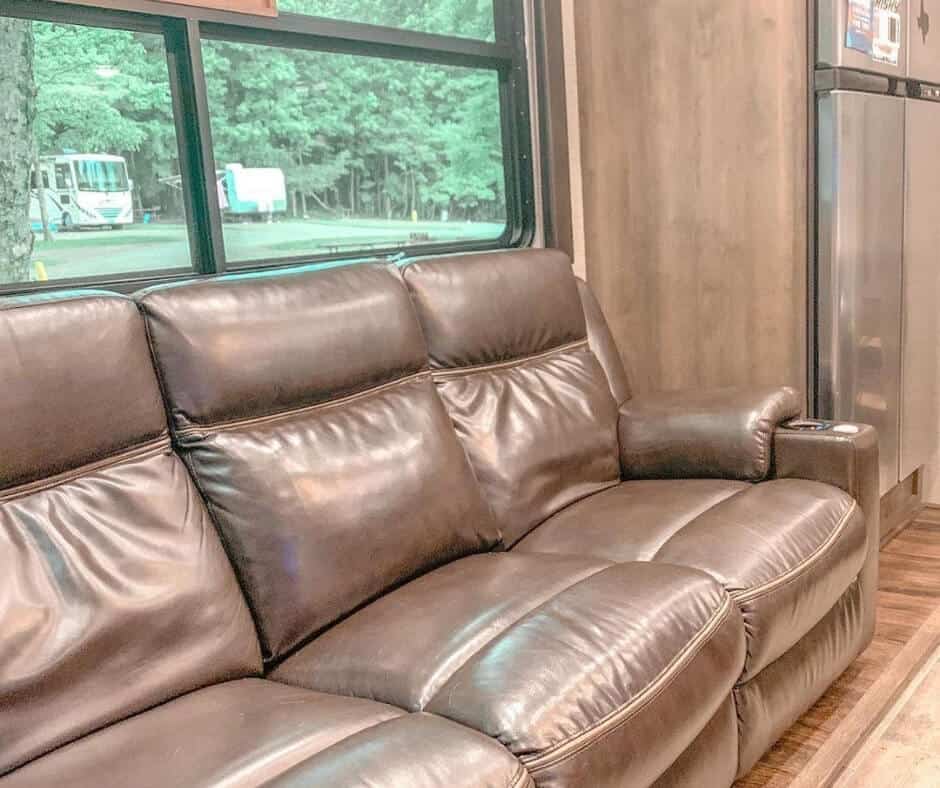
If you’re traveling with a trailer or fifth wheel, everyone needs to sit in the towing vehicle.
If you need to use the camper’s bathroom or kitchen, pull over or take a break at a rest stop or parking lot to use your camper’s facilities.
Can You Walk Around Inside An RV While Driving?
As much as possible, all passengers in an RV should stay seated and buckled in while the camper is moving.
It’s technically illegal to get up from your seat and walk around the RV while it is in motion, however many RVers take the risk and occasionally get up to use the bathroom or grab something from the kitchen.
Doing so can be dangerous, especially if the driver has to brake suddenly, the road gets bumpy, or the motorhome gets into an accident.
It’s safer to pull over or make a stop somewhere if passengers need a bathroom break or a snack.
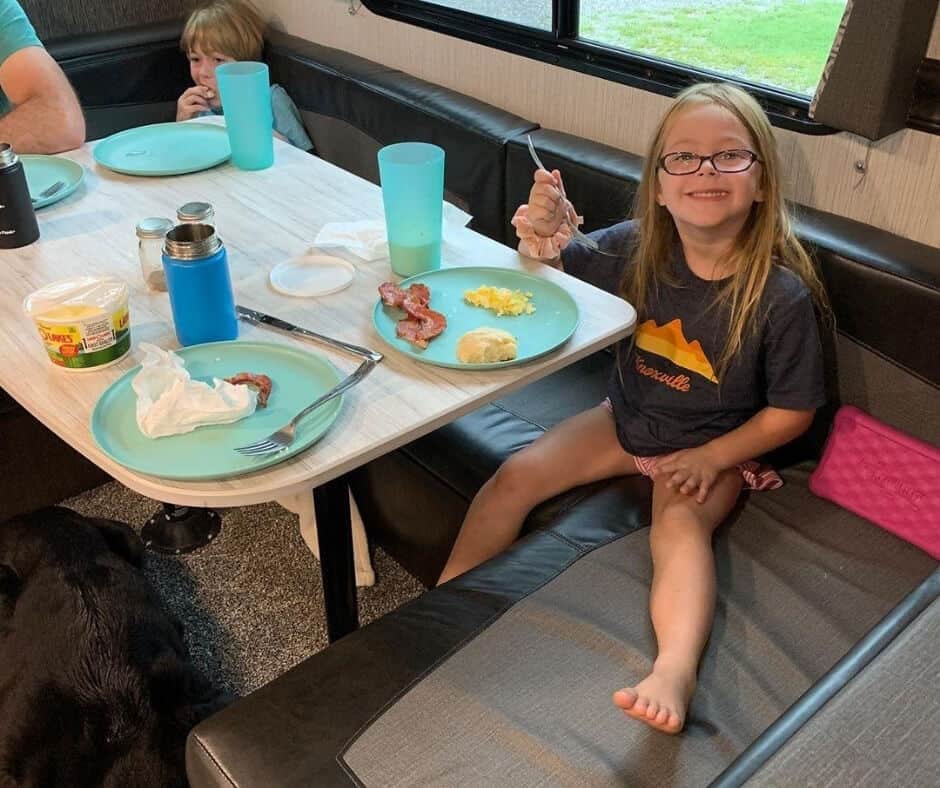
Can You Sleep In An RV While Driving?
Beyond just sitting in your RV or walking around while you’re on the road, a common question RVers have is whether or not you can sleep in the motorhome while driving.
If you are on a long road trip, why not take the driving in shifts so one person can rest for a few hours while the other gets you closer to your next destination?
Unfortunately, sleeping in an RV while someone else drives is not safe or legal. Most states require all passengers to be buckled in while the vehicle is moving, and sleeping on the bed would violate those laws. Unless you can sleep sitting up and buckled in, you can’t sleep in your RV while it is moving.
It would also be dangerous to sleep on the bed, since you could be severely or even fatally injured if the motorhome were involved in an accident.
Luckily, there are rest stops along highways as well as stores like Walmart where you can safely stop and get some sleep for a few hours before continuing on your trip.
Comparing Seating vs. Sleeping Space in a Camper
Another thing to consider about sleeping in an RV, whether it’s moving or not, is whether the sleeping setup is converted from passenger seating, or standalone beds.
In larger RVs, the sleeping accommodations might be areas that act as seating or dining space during the day, but change to a bed at night.
You should also never sleep in the loft above the driving cab while the RV is moving, since the motion of the vehicle could cause you to roll off of the elevated space and fall to the floor, injuring yourself.
Of the three types of RVs (Class A, B, and C), there are some differences to be aware of regarding the space for seated passengers versus sleeping areas:
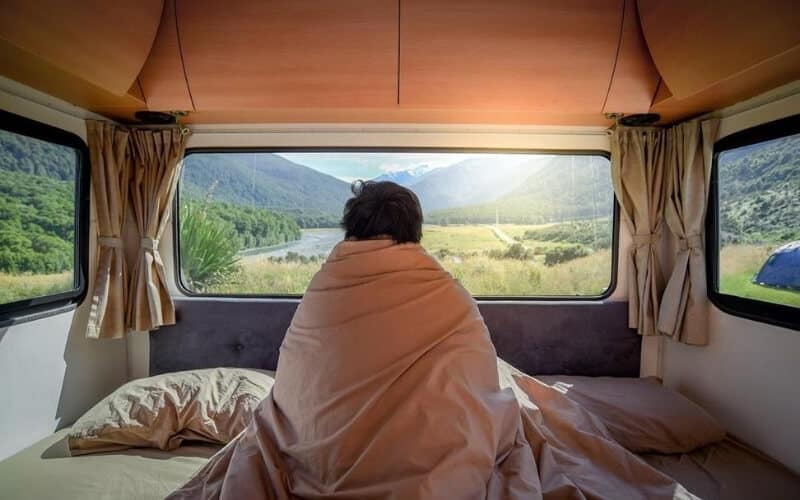
Can You Use An RV Bathroom While Driving?
Previously in this article, we’ve discussed how you should try not to walk around your RV while it’s moving and stay seated and safely buckled in as you travel.
Although it’s not technically safe, you can get up briefly to use the bathroom in an emergency.
We recently published an article to dig deeper about whether you can use the bathroom in an RV while driving, so be sure to check it out if you want to learn more.
Can You Cook In An RV Camper While Driving?
If it’s not safe to walk around in your RV while it’s moving, it’s even less safe to cook while on the road.
RV stoves often use propane for cooking, which is a dangerous thing to add to the mix with the whole vehicle in motion. So, you should never cook in your RV while traveling. If you must make a meal during the trip, pull over or take a break at a rest stop, where it’s more safe and convenient to cook.
Not only is cooking in a moving RV unsafe, it’s also difficult and cumbersome.
You’re already cooking in a confined space, and as the vehicle moves, you may struggle to keep hot pans on the stove, stop dishes and food from falling off of the counters, and other disasters just waiting to happen if the RV goes over a bump or hits a rough patch in the road.
Summary About Being in An RV While Driving
When it comes down to it, the best thing for you and all other passengers to do while traveling in an RV is stay seated with a seat belt.
Minimize moving around in the RV, and pull over if anyone needs to use the bathroom, cook a meal, or walk around. It’s not safe, and it’s illegal in most states.
There are lots of blogs about there that give you ideas for how to stay occupied or keep kids from getting bored during a road trip in an RV, so be sure to consult the internet if that’s a concern.


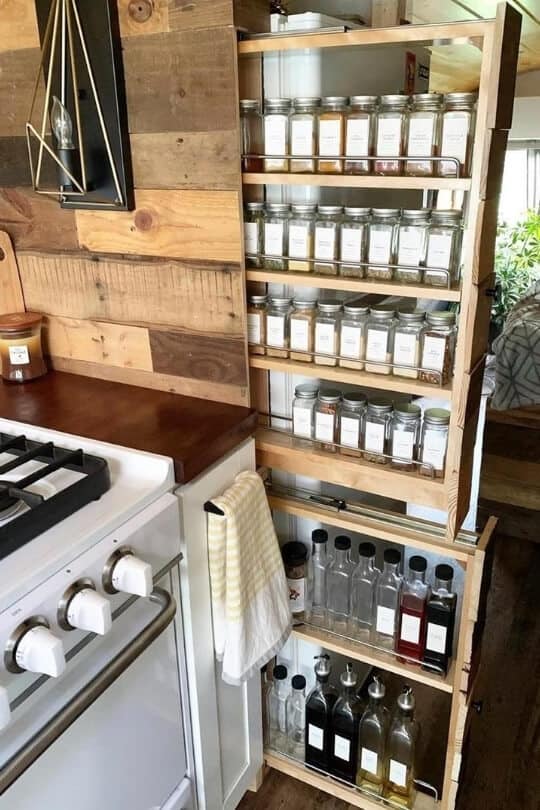
![12 Best Lightweight Small Truck Campers on [currentyear] RV Market 7 small truck campers](https://www.rvingknowhow.com/wp-content/uploads/2020/05/small-truck-campers-150x150.jpg)
![6 Best Solar-Powered Generators for Portable Power Stations in [currentyear] 8 The Best Solar Generators For Camping](https://www.rvingknowhow.com/wp-content/uploads/2021/03/The-Best-Solar-Generators-For-Camping-150x150.jpg)

